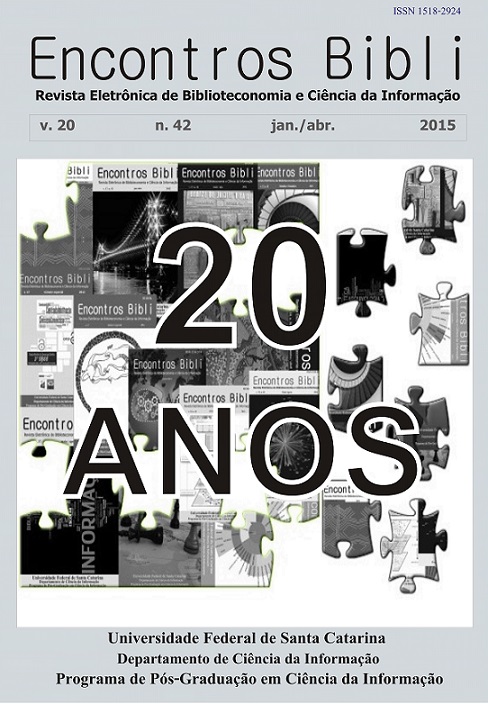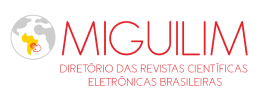Bibliological analysis: security tool in collections of rare books
DOI:
https://doi.org/10.5007/1518-2924.2015v20n42p17Keywords:
Analysis bibliological, Rare Books Librarianship, Security against theftand robbery, Rare BooksAbstract
The historical-cultural and economic value of rare book makes the same is often the object of robbery and theft of rare books. Therefore, the guardians of this type of library institutions have to strengthen their safety in order to inhibit such criminal practice. This paper, through literature review has the objective analyzing the possibility of using bibliological analysis as a security tool. Because with the detailed description of the copies is possible to increase the knowledge about the collection of an institution and attribute unequivocal property to rare specimens, that not always receive stamps or other marks, making it difficult to return the books in case of robbery and theft and possible recovery thereof. Therefore, the bibliological analysis individualizes the exemplary, besides allowing the handling and extensive knowledge of this, essential factors to security of the books.
Downloads
References
ARAÚJO, E. A construção do livro: [princípios da técnica de editoração]. São Paulo: Editora UNESP, 2008.
BERTINAZZO, S. M. F. Ex libris: pequeno objeto do desejo. Brasília: EdUnB, 2012.
CAMPBELL, D. Dealer who stole rare maps faces jail and £1m fines. The Guardian, 24 jun. 2006. Disponível em: <http://www.guardian.co.uk/uk/2006/jun/24/books.ukcrime>. Acesso em: 16 jun. 2014.
CHRISTIE`S. Disponível em: <http://www.christies.com/>. Acesso em: 13 jun. 2014.
FARIA, M. I.; PERICÃO, M. G. Dicionário do livro: da escrita ao livro eletrônico. São Paulo: Edusp, 2008.
GAUZ, V. De roubos e roubos. Info Home, out. 2005. Disponível em: <http://www.ofaj.com.br/colunas_conteudo.php?cod=231>. Acesso em: 16 jun. 2014.
______. Da Itália para o mundo: o roubo de livros da Biblioteca Girolamini. Info Home, dez. 2013. Disponível em: <http://www.ofaj.com.br/colunas_conteudo.php?cod=802>. Acesso em: 16 jun. 2014.
HONIGSBAUM, M. Throw book at thief, says library. The Guardian, 15 set. 2006. Disponível em: <http://www.guardian.co.uk/uk/2006/sep/15/books.ukcrime>. Acesso em: 16 jun. 2012.
KUSHNIR, B. Da manchete à notinha de canto: os furtos do patrimônio público, a privatização dos acervos do cidadão. Museologia e Patrimônio, v. 2, p. 9-21, 2009. Disponível em: <http://revistamuseologiaepatrimonio.mast.br/index.php/ppgpmus/issue/current/showTocm>. Acesso em: 16 jun. 2014.
LADRÕES ROUBAM cem obras raras em Campinas. Folha de São Paulo, 13 ago. 2013. Disponível em: <http://www1.folha.uol.com.br/ilustrada/2013/08/1325747-ladroes-roubam-cem-obras-raras-em-campinas.shtml>. Acesso em: 16 jun. 2014.
MANSO, B. P.; GODOY, M. Trio rouba livros raros de botânica em SP e diz ser “encomenda internacional”. Estadão, 02 fev. 2012. Disponível em: <http://www.estadao.com.br/noticias/cidades,trio-rouba-livros-raros-de-botanica-em-sp-e-diz-ser-encomenda-internacional,830662,0.htm>. Acesso em: 16 jun. 2014.
MORAES, R. B. O bibliófilo aprendiz. 4ª ed. Brasília: Briquet de Lemos, 2005.
PINHEIRO, A. V. Catalogação de livros raros: proposta de metodologia de formalização de notas especiais para difusão, recuperação e salvaguarda. In: I ECONTRO NACIONAL DE CATALOGADORES E III ENCONTRO DE ESTUDOS E PESQUISAS EM CATALOGAÇÃO, out. 2012, Rio de Janeiro. Disponível em: <http://pt.scribd.com/doc/109278012/Catalogacao-de-livros-raros-proposta-de-metodologia-de-formalizacao-de-notas-especiais-para-difusao-recuperacao-e-salvaguarda>. Acesso em: 16 jun. 2014.
______. Livro raro: antecedentes, propósitos e definições. In: SILVA, H. C.; BARROS, M. H. T. C. (Orgs.). Ciência da Informação: múltiplos diálogos. Marília: Cultura Acadêmica, 2009, p. 31-44. Disponível em: <http://www.marilia.unesp.br/Home/Publicacoes/helen_e%20book.pdf>. Acesso em: 16 jun. 2014.
REIFSCHNEIDER, O. D. B. A importância do acesso às obras raras. Revista Ibero-Americana de Ciência da Informação, v. 1, n. 1, jan./abr. 2008. Disponível em: <http://seer.bce.unb.br/index.php/RICI/article/view/1544/2330>. Acesso em: 16 jun. 2014.
RODRIGUES, A. H.; CALHEIROS, M. F.; COSTA, P. S. Análise bibliológica de livros raros: a preservação ao “pé da letra”, in Anais da Biblioteca Nacional, Rio de Janeiro, v. 123, p. 33-48, 2007. Disponível em: <http://www.bn.br/planor/documentos/anais_123_2003.pdf>. Acesso em: 16 jun. 2014.
RODRIGUES, M. C. Como definir e identificar obras raras?: critérios adotados pela Biblioteca Central da Universidade de Caxias do Sul. Revista Ciência da Informação, Brasília, v. 35, n. 1, p. 115-121, jan./abr. 2006. Disponível em: <http://eprints.rclis.org/8336/1/v35n1a12.pdf>. Acesso em: 02 dez. 2011.
SANT’ANA, R. B. Critérios para a definição de obras raras. Revista Online Biblioteca Prof. Joel Martins, Campinas, v. 2, n. 3, p. 1-18, jun. 2001. Disponível em: <http://www.fe.unicamp.br/revista/index.php/etd/article/view/1886/1727>. Acesso em: 16 jun. 2014.
SILVA, F. Critérios de seleção de obras raras adotados em bibliotecas do Distrito Federal. 2011. Dissertação (Mestrado em Ciência da Informação) – Universidade de Brasília, Brasília, 2011. Disponível em: <http://repositorio.unb.br/bitstream/10482/9202/1/2011_FernandoSilva.pdf>. Acesso em: 16 jun. 2014.
SOTHEBY`S. Disponível em: <http://www.sothebys.com/en.html>. Acesso em: 13 jun. 2014.
Downloads
Published
How to Cite
Issue
Section
License
Copyright (c) 2015 Raphael Diego Greenhalgh, Miriam Paula Manini

This work is licensed under a Creative Commons Attribution 4.0 International License.
The author must guarantee that:
- there is full consensus among all the coauthors in approving the final version of the document and its submission for publication.
- the work is original, and when the work and/or words from other people were used, they were properly acknowledged.
Plagiarism in all of its forms constitutes an unethical publication behavior and is unacceptable. Encontros Bibli has the right to use software or any other method of plagiarism detection.
All manuscripts submitted to Encontros Bibli go through plagiarism and self-plagiarism identification. Plagiarism identified during the evaluation process will result in the filing of the submission. In case plagiarism is identified in a manuscript published in the journal, the Editor-in-Chief will conduct a preliminary investigation and, if necessary, will make a retraction.
This journal, following the recommendations of the Open Source movement, provides full open access to its content. By doing this, the authors keep all of their rights allowing Encontros Bibli to publish and make its articles available to the whole community.
Encontros Bibli content is licensed under a Creative Commons Attribution 4.0 International License.
Any user has the right to:
- Share - copy, download, print or redistribute the material in any medium or format.
- Adapt - remix, transform and build upon the material for any purpose, even commercially.
According to the following terms:
- Attribution - You must give appropriate credit, provide a link to the license, and indicate if changes were made. You may do so in any reasonable manner, but not in any way that suggests the licensor endorses you or your use.
- No additional restrictions - You may not apply legal terms or technological measures that legally restrict others from doing anything that the license permits.

























